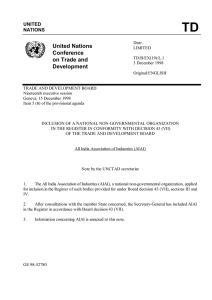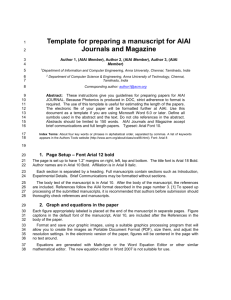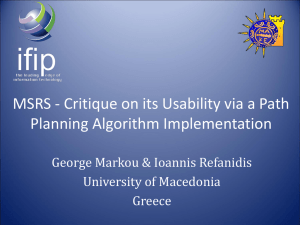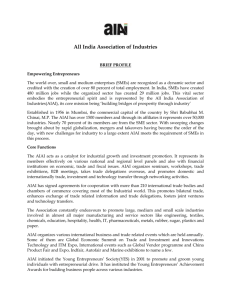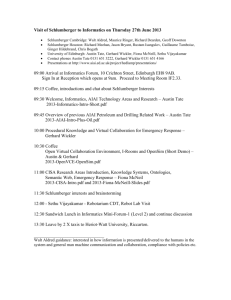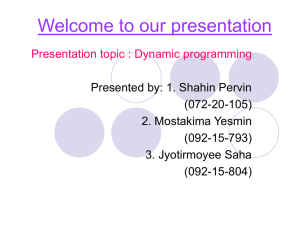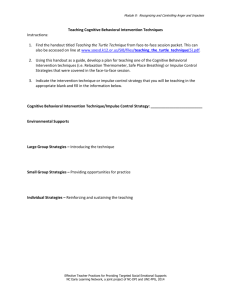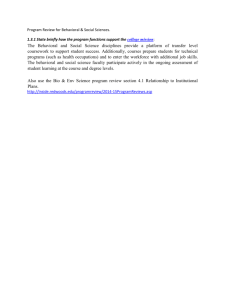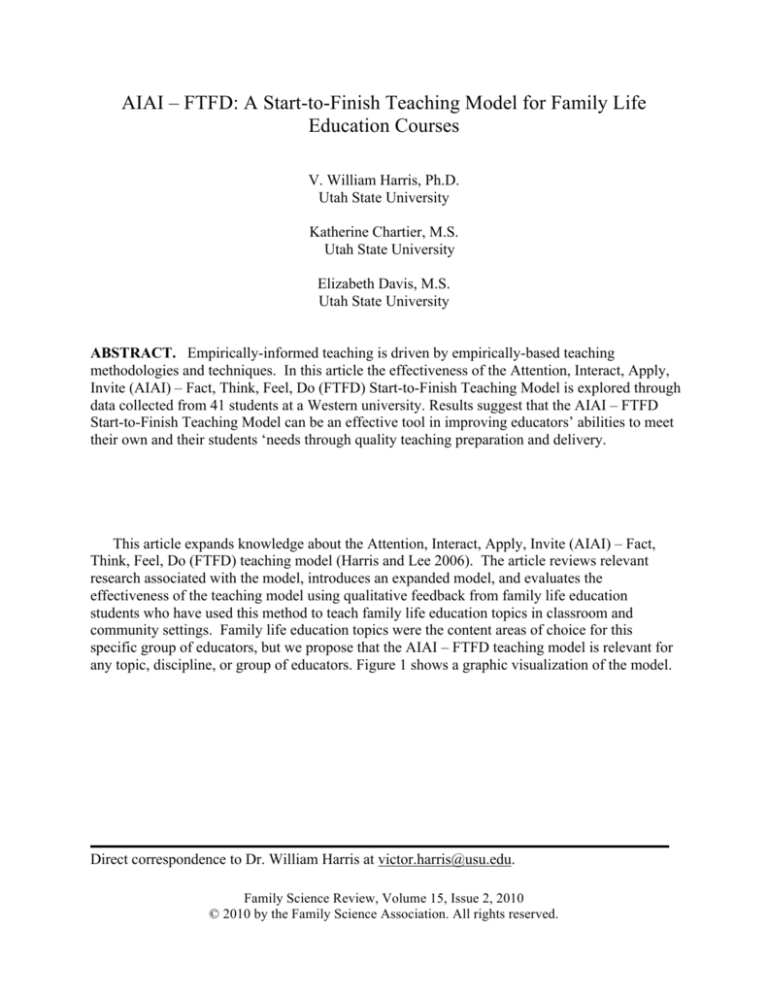
AIAI – FTFD: A Start-to-Finish Teaching Model for Family Life
Education Courses
V. William Harris, Ph.D.
Utah State University
Katherine Chartier, M.S.
Utah State University
Elizabeth Davis, M.S.
Utah State University
ABSTRACT. Empirically-informed teaching is driven by empirically-based teaching
methodologies and techniques. In this article the effectiveness of the Attention, Interact, Apply,
Invite (AIAI) – Fact, Think, Feel, Do (FTFD) Start-to-Finish Teaching Model is explored through
data collected from 41 students at a Western university. Results suggest that the AIAI – FTFD
Start-to-Finish Teaching Model can be an effective tool in improving educators’ abilities to meet
their own and their students ‘needs through quality teaching preparation and delivery.
This article expands knowledge about the Attention, Interact, Apply, Invite (AIAI) – Fact,
Think, Feel, Do (FTFD) teaching model (Harris and Lee 2006). The article reviews relevant
research associated with the model, introduces an expanded model, and evaluates the
effectiveness of the teaching model using qualitative feedback from family life education
students who have used this method to teach family life education topics in classroom and
community settings. Family life education topics were the content areas of choice for this
specific group of educators, but we propose that the AIAI – FTFD teaching model is relevant for
any topic, discipline, or group of educators. Figure 1 shows a graphic visualization of the model.
Direct correspondence to Dr. William Harris at victor.harris@usu.edu.
Family Science Review, Volume 15, Issue 2, 2010
© 2010 by the Family Science Association. All rights reserved.
AIAI – FTFD Start-to-Finish Teaching Model 16
Figure 1: Instructional Preparation and Delivery
The AIAI – FTFD Start-to-Finish Teaching Model
©V. William Harris
Preparation: Topic:
Student Need(s):
Overall Goal:
Content 2-3 Concepts/Principles:
Skills/Target-Cognitive/Emotional/
Objectives:
Behavioral Processes:
Cognitive –
Emotional –
Behavioral –
Role: Facilitator, Expert, Consultant….Delivery Strategies: AIAI, FTFD, Variety
Unit/Section Instructor Will Do Learner Will Do
Content
Mental
Method
(List Items)
(List Items)
(Circle Items)
(Circle Items)
Process
1. Facts
2. Concepts
3. Principles
(Circle Items) 1. Audio
1. Remember 2. Visual
2.Understand 3. Praxis
3. Apply
4. Analyze
5. Evaluate
6. Solve
7. Create
8. Design
Delivery: Lesson Outline AIAI, FTFD, Variety…………Role: Expert, Facilitator, Consultant
Attention:
Interaction:
Apply:
Practice Target Skill: Cognitive/Emotional/Behavioral
Invite:
AIAI – FTFD Start-to-Finish Teaching Model 17
AIAI: Attention, Interact, Apply, Invite
Attention. Before a teacher can teach effectively, the teacher must catch the students’
attention so they are prepared to be taught. Neglecting this principle has been the downfall of
many teachers who could have been successful otherwise. A short humorous story, joke, video
clip, object lesson, dramatization, question, game, etc., that creates interest in discovering what
will be taught in the specific class can be very effective attention ideas. For the attention idea to
be effective, it must be able to take the students’ minds off of the outside distractions/influences
they may have entered the classroom with and focus the students as a unified whole on
discovering the information the teacher is about to lead them into. The attention idea need not be
lengthy. In fact, it is better if it is not.
Interact. Next, the teacher proceeds with the introduction of the workshop or
presentation information. Effective teachers use interaction methods such as insightful
questioning, object lessons, student sharing, stories, dramatizations, group activities, etc., that
center on the student and not the teacher. In other words, the mindset that the effective
interactive teacher should have is as a facilitator of information and discussion, not as a standand-deliver lecturer.
Apply. After a principle is taught, the teacher must help or elicit the students to make
applications to their own lives. A crucial key to successful teaching is to spend as much time on
applying the principles and information as possible with the students in order to help them access
potential new skills that can help them change their teaching, lives, and relationships.
Invite. Lasting change is less likely to occur unless the students are invited to choose a
principle or a piece of information from each class they can add to their repertory of teaching
skills. Providing an invitation and then a method of targeting specific skills or behavioral change
as homework, outside of the classroom setting, is also crucial to the effective instructional
process .
FTFD – Effective Questioning Techniques
Effective questioning begins with an understanding of the FTFD method of questioning.
Note that that each FTFD component parallels the corresponding AIAI component (e.g.,
Attention corresponds to Fact, Interact corresponds to Thinking, Feel corresponds to Apply, and
Do corresponds to Invite).
F is for Fact. Initial questioning begins with questions that are factual in nature. For
example, “What is the current divorce rate in the nation?” or “Does anyone know what the 3 C’s
of marriage represent?”
T is for Thinking. Thinking questions mark the next stage in the process of helping
students conceptualize the principles and to move toward the application of the principles into
their individual lives. For example, a teacher might ask, “Why do you think the divorce rate is
so high?” or, “Why do you think Communication, Conflict management, and Commitment might
be considered three major keys to a successful marriage?” This kind of thinking can be used for
every kind of attention or involvement idea. For example, a teacher might ask, “Now, why do
you think I would show you this video clip, tell you this story, or use this example?” Similarly,
the teacher might ask, “What does this object lesson have to do with your marriage?” The
students are then free to move to a deeper level of thinking – a level that prepares them for
application (i.e., Feeling and Doing).
AIAI – FTFD Start-to-Finish Teaching Model 18
F is for Feeling. This is the level of questioning where change begins to occur. For
example, a teacher might ask the students, “How do you feel about this principle or about what
we have discussed?” or, “What have you learned about your own conflict management style and
how it contributes to or detracts from your relationship?”
D is for Doing. As the students begin to make application of the principles and
information being taught, they need to be invited to “Do” something to enact change in their
lives. This invitation can be initiated by the teacher, by the students themselves, or by one or
both members of a relationship dyad. For example, a teacher might say, “I would invite you to
choose one thing you would like to work on as a couple for the next week” or, “I would like you
to think about conflict management. Is there something you could do differently that would help
you manage conflict more efficiently?” or, “Was there a time during the class when you felt
there was something you could specifically do that could benefit your close relationships? I
invite you to choose that one item/skill and to work on it as your homework assignment for the
coming week.”
Preparation: A New Addition to the Model
We added Preparation to the model to assist teachers in clarifying important components of
teaching such as assessing student needs, targeting cognitive/emotional/behavioral skills,
determining learning objectives, and deciding upon an overall goal for the learning experience.
Similarly, specifying what both the learner and teacher will accomplish during the learning
experience along with pinpointing different kinds of content, mental processes, and learning
methods are highlighted as a means to guide the Delivery segment of the model (see Figure 1).
Needs Assessment
A needs assessment may consist of a technique as simple as asking the audience before class
what they hope to get out of the experience and then periodically asking class members if what
they are learning is helpful. There are multiple ways needs assessments can be conducted (e.g.,
focus groups, interviews, questionnaires, etc.) prior to teaching (Powell & Cassidy, 2007). One
key to assessing audience needs is to know something developmentally about the group before
they arrive and then to use appropriate methods to assess their needs and how they are being met
throughout the teaching process. For example, if the audience consists of teenagers, the teacher
would want to already know that the group is likely experiencing identity issues and that they
may be confused about what roles they should play in a given situation (see Erickson, 1968).
Choosing Content: 2-3 Concepts or Principles
Once student needs have been assessed, content can be chosen that specifically addresses the
needs of the audience, understanding, of course, that sometimes the content students must learn
is pre-determined, such as in academic courses. There are at least three types of content: facts,
concepts, and principles. A fact is a piece of knowledge that has been “shown to be true, to
exist, or to have happened;” a concept is a “broad abstract idea” that requires conscious thought
and understanding in order to associate the abstract idea with meaning; a principle is a concept
that can be applied to multiple contexts such as “one that determines how a person or culture
behaves, or how nature, reality, or events are perceived” (Encarta, 2003).
As a result, a principle is distinguished from a concept in that it is “an important underlying
law or assumption required in a system of thought” and can be used as “a standard of moral or
ethical decision-making” (Encarta, 2003). Therefore, principles represent the highest order of
AIAI – FTFD Start-to-Finish Teaching Model 19
knowledge because they incorporate facts and concepts to reveal underlying laws or assumptions
that can be applied to make cognitive, emotional, and behavioral decisions – decisions that
ultimately lead to change.
Targeting Cognitive/Emotional/Behavioral Skills
Once student needs have been assessed, and content to be taught and learned has been
determined, appropriate cognitive, emotional, and behavioral skills can be targeted. For
example, William E. Herman (2008), instructor of psychology, has targeted “. . . the exploration,
creation, advancement, maintenance, critical assessment, and reality testing of knowledge” as the
primary cognitive skills he wants his students to learn.
The major emotional skill that is typically targeted by teachers is helping their students gain
confidence in understanding and applying the subject matter to their own real-world experiences.
However, other emotional skills such as self-awareness, emotional regulation, sympathy,
empathy, harnessing emotions productively, and handling relationships (e.g., in a team setting)
may also be targeted by teachers (Goleman, 1995).
Behavioral skills that are targeted by teachers for their students to learn vary widely across
disciplines. For example, a teacher of human development may want his students to master the
nine relationship skills introduced by Gottman (1994) while a computer science instructor may
want his students to master basic computer programming skills by creating a tangible product
such as designing multiprogramming operating systems (Brouwer, 2008).
When cognitive, emotional, and behavioral skills are targeted, they need to be operationalized
by teachers so their students can practice them in-class, at least for a few minutes. Homework is
included in the Attention, Interact, Apply, Invite (AIAI) – Fact, Think, Feel, Do (FTFD) Start-toFinish Teaching Model as an invitation and is critical to the ongoing development of whatever
skills the teacher or student targets.
Determining Learning Objectives and Deciding Upon an Overall Teaching Goal
When student needs have been assessed, content to be taught and learned has been
determined, and appropriate cognitive, emotional, and behavioral skills have been targeted, the
teacher can then determine corresponding objectives. Concerning the creation of teaching
objectives, Duncan and Goddard (2005) have stated:
Well-designed teaching plans would include goals and specific, measurable leanercentered objectives, focused on producing changes in participant knowledge, attitudes,
behavior/skills, and aspirations (p. 40)
Learner-centered objectives might include items such as those taken from a methods of teaching
course in family life education. While these objectives represent those scripted for an entire
course, the instructor can pull from these objectives when teaching individual presentations to
make sure that he is on track. Once these objectives are specified, an overall teaching goal can
be determined for the course, and for each presentation.
Teaching Roles
There are many roles family life educators can play when presenting information. These roles
include: expert, facilitator, critical inquirer, collaborator, interventionist, and eclectic (Duncan &
Goddard, 2005). However, three of these roles apply more directly to family life educators: the
AIAI – FTFD Start-to-Finish Teaching Model 20
expert, consultant, and facilitator (Powell & Cassidy, 2007). According to Powell and Cassidy,
the expert role assumes the instructor possesses all the answers and there is little student
involvement. Experts are limited by a set agenda and often do not consider participant feedback
such as personal perspectives or experiences. Consultants use group processes to combine their
expertise and the participant’s knowledge and circumstances. During these processes, needs tend
to drive the presentation and are assessed often. Consultants readily involve participants and
elicit feedback. Facilitators share leadership by instigating group discussion and focusing on
participant’s strengths and experiences to solve a problem or to explore a topic while limiting
their own opinions or input in order to promote interaction.
Specifying What the Teacher and the Learner Will Do
Once the above steps have been accomplished, the teacher must specify exactly what he or
she would like to accomplish during the teaching presentation and exactly what the learners are
expected to do (see Allington & Cropper, 1994; Cropper, 2000). For example, the teacher might
resolve to do the following:
1. Provide motivation for the students to come to class having read the reading
assignment.
2. Present 2-3 principles clearly by teaching “less better.”
3. Facilitate discussion by writing out each Fact, Think, Feel, Do question so as not to
stymie the discussion process.
4. Remain flexible so students can ask questions and co-participate in guiding the
learning process.
5. Facilitate skill development by allowing students to practice the skills being taught inclass.
6. Offer an effective invitation with an accompanying homework assignment so students
can continue to practice mastering the target skills outside of the classroom.
Correspondingly, the teacher might list the following things that learners will do:
1. Come to class prepared, having read the reading assignment for the day.
2. Ask questions and interact with each other, the teacher, and the principles being
taught.
3. Apply the information being taught to their own real-world experiences.
4. Practice the skills being taught in class.
5. Practice the skills being taught outside of class.
The teacher will want to tailor each item he or she lists to individual presentations based upon
the needs assessment, content chosen, target behaviors, objectives, and overall teaching goals.
Pinpointing Content, Mental Processes, and Learning Methods
We have already discussed three kinds of content above (i.e., facts, concepts, and principles).
Guiding the teacher to review the content level allows a self-check to make sure that facts,
concepts, and principles are appropriately balanced in the teaching presentation.
The mental process section in the Preparation segment of the model also serves as a selfcheck measure to help the teacher identify what kinds of mental processes (i.e., remember,
understand, apply, analyze, evaluate, solve, create, design) will be used to engage the students.
Bloom’s taxonomy exposes the problem associated with so much of ineffective teaching, which
is that many instructors “teach facts to the test” and focus primarily on “remember” and
“understand” as the two major mental processes of learning. When students are only required to
AIAI – FTFD Start-to-Finish Teaching Model 21
remember facts and understand concepts without applying this information to their own
experience, few points of engagement are created. Conversely, when student interest is sparked
and they are challenged and motivated to not only use the mental processes of remember and
understand, but to analyze, evaluate, solve, design, and create while making application to their
own real-world experiences, it opens up an avenue of cognitive, emotional, and behavioral
growth, development, and change.
Barbe (1985) cited three basic ways learners receive information: auditory, visual, and
kinesthetic. Individuals usually prefer one style of learning over the others. Allington and
Cropper (1994) described media methods through which individuals receive information such as
hands-on, spoken word, printed word, symbols, and feelings, which can be classified as follows:
1) Auditory learning: spoken words and feelings, 2) Visual learning: printed words or symbols,
and 3) Kinesthetic learning: hands-on. A variety of auditory, visual, and kinesthetic activities
should be incorporated into lesson plans thus engaging all styles of learners.
Verification of the Model
The authors implemented the AIAI-FTFD model with 41 university students selected from a
combination of 3 Methods of Family Life Education 15-week courses over two semesters. The
students, 36 females and 5 males, were required to prepare a teaching outline using the AIAI –
FTFD teaching methodology and choose their own topic to present, approved by the instructor.
Students met with the instructor at least once to review their teaching outlines and to make any
necessary changes. This allowed the instructor to assess how well they understood the AIAI –
FTFD teaching methodology and to carefully review all strategies, methods, and questions to be
presented. Students practiced their teaching skills using the AIAI – FTFD teaching methodology
with another student and in small groups. They presented their topic in front of the class and
were to be evaluated by each class member.
After a careful review of the evaluations from other class members, students revised their
teaching outlines and then presented a revised version to a group outside the university, at
schools, community organizations, or businesses.
As an extra credit option on the last day of class, students were asked to respond to the
question, “Describe how you feel about the AIAI and FTFD teaching methodologies. Were they
helpful? Why or why not?”
The researchers analyzed student responses for themes. Almost every student participant (35
out of 41) indicated explicitly or implicitly that the AIAI –FTFD teaching methodology was
helpful, useful, and/or beneficial. Specifically, they reported how it helped them meet not only
their own needs as teachers but also how it helped them meet their students’ needs (both of
which were important sub-themes in this study). For example, one participant wrote,
AIAI/FTFD provided a useful, easy to understand, and successful outline for getting the
audience to engage in a lesson and allows the teacher to think completely through what
will be taught giving confidence to them and allowing them to better “score” with their
audience. It has helped me to meet my own teaching needs and understand and meet my
audience’s needs.
When considering their own needs as teachers, participants indicated that the teaching model
gave them confidence to teach and helped them feel more prepared and organized. One
participant wrote, “[AIAI – FTFD] allows you to be confident in teaching because you know
AIAI – FTFD Start-to-Finish Teaching Model 22
exactly what you are teaching, what you want to say, the direction you want to go in, and there is
still room for flexibility.” Another participant wrote, “It really helps [you as the teacher] sort
through information and present it in the best way possible for the audience.”
Another student described how AIAI – FTFD helped teachers meet student needs:
It helps get the class thinking and involved in discussion through the outline of Attention,
Interact, Apply, Invite and Fact, Think, Feel, Do. This method should be used by all
Family Life Educators because it is so effective in getting the message across and in
helping teach and apply new skills to those who need them!
Another student articulated how AIAI – FTFD helped engage the audience:
It is smart to get the attention of the audience and get them interacting before applying
the information. When involving the class, the invite becomes much more meaningful.
FTFD is helpful in creating the key questions you want to ask the audience. By asking,
what do you know, what do you think, how do you feel, and what will you do, it really
gets the audience to think about what they are being taught, participate by sharing
answers, and hearing from each other. Feeling something about the information being
taught makes it personal and encourages action.
Another student expressed a similar sentiment, “. . . as we practiced it [AIAI – FTFD] seemed
to help us effectively engage our audience, and led to more structured, powerful facilitation.”
Another student wrote:
I think it’s great! It’s helped me in class and is very applicable. I’ve used the strategy in
teaching a group of young women and I’ve noticed how much more they are engaged in
the lesson. It’s also more fun to teach. YES! It was helpful. It helped me think about
how I teach and helped me focus more on improving my teaching. It’s a great idea and
I’m very glad I was introduced to it in the class. I plan to use it much more in the future!
Conclusion
Based on the responses of these 41 students, we believe that the teaching model has practical
significance for family life educators in preparing and delivering presentations. The model is
simple to use, and is universal in design. The model conceptualizes principles of effective
teaching in a step-by-step start-to-finish outline for family life educators and has the potential to
help family life instructors be more effective in preparing and delivering information relevant to
individuals and families.
AIAI – FTFD Start-to-Finish Teaching Model 23
References
Anderson, L. W., & Krathwohl, D. R. (Eds.). (2001). A taxonomy for learning, teaching and
assessing: A revision of Bloom's Taxonomy of educational objectives: Complete edition.
New York: Longman.
Allington, D., & Cropper, M.H. (1994). A new, complete paradigm for instruction: A model for
teaching and learning for the 21st century. Utah State University: Unpublished
Manuscript.
Barbe, W.B. (1985). Growing up learning. Washington, DC: Acropolis Books.
Bloom, B.S., & Krathwohl, D.R. (1956). Taxonomy of educational objectives: The classification
of educational goals, by a committee of college and university examiners. Handbook 1:
Cognitive domain. New York: Longmans.
Brouwer, P. (2008). Group projects in computer science. In R. L. Badger (Ed.), Ideas that work
in college teaching. Albany, NY: State University of New York Press.
Cropper, M.H. (2000). A comprehensive instructional model for the new millennium. Paper
presented at the NETg Lecture Series, University of Limerick, Limerick, Ireland.
Duncan, S., Goddard, H.W. (2005). Family life education: Principles and practices for effective
outreach. Thousand Oaks, CA: Sage Publications.
Encarta (2003). Retrieved 16, July, 2009 from: Microsoft Word Dictionary.
Goleman, D. (1995). Emotional intelligence: Why it can matter more than IQ. New York:
Bantam.
Gottman, J.M. (1994). Why marriages succeed or fail. New York: Fireside.
Harris, V.W. & Lee, T. (2006). Using empirically-based teaching methodologies to teach family
life education topics effectively. Journal of Teaching Marriage and Family, 6, 121-139.
Online: http://www.familyscienceassociation.org/Journal%20articles/Harris%20Lee.pdf
Herman, W.E. (2008). Psi fi: Learning psychology through active engagement in science fiction.
In R. L. Badger (Ed.), Ideas that work in college teaching. Albany, NY: State University
of New York Press, p. 121.
Powell, H., & Cassidy, D. (2007). Family life education: Working with families across the life
span. Long Grove, IL: Waveland Press.

